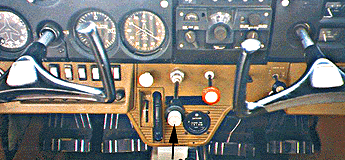-
Go or whoa?
 I'm
taking flying lessons. Here is the instrument panel
in the airplane; a Cessna 150. There is a knob
with a silver tip about halfway between the two
steering controls. This is the speed control. It
pushes in and out. Guess which way causes the airplane
to go faster, all the way in or all the way out?
I'm
taking flying lessons. Here is the instrument panel
in the airplane; a Cessna 150. There is a knob
with a silver tip about halfway between the two
steering controls. This is the speed control. It
pushes in and out. Guess which way causes the airplane
to go faster, all the way in or all the way out?
Let me give you a hint. The white knob to the left is the carburetor heat. Pulling it all the way out turns on the heat, pushing it all way in turns off the heat.
If you guessed that pulling the speed control all the way out makes the plane go faster, you'd be wrong. Pushing all the way in makes the plane go faster. Although it doesn't seem like it would be hard to learn this, it is. A friend who is also taking flying lessons told me to think about riding a horse. Pull back to "Whoa", release (push in) to "Go".
Design suggestion
People expect a standard control such as a push/pull knob to have a standard relationship between the knob position and function. For a push/pull knob, pulling the knob "increases" the function whereas pushing the knob "decreases" the function.
 Readers' comments
Readers' commentsThere's an interesting historical reason, or better, standardization reason, for the direction of throttle movement: The traditional aircraft throttle is a lever sticking up somewhere. (Between the seats if there are two control positions.) You push the lever forward to go and pull it back to slow. The Cessna is cheaper. It doesn't have the lever. Instead there is a knob on the end of the rod that the lever would push and pull. And pushing and pulling on that rod sticking out of the instrument panel gets counterintuitive. But it would be far worse to have the throttle in the Cessna work in the opposite direction from the throttle in all other airplanes.
-DHIf you think of the three controls (l-r: carburetor heat, throttle, and mixture) as being ON-OFF controls, you may feel that all of the ON directions should be in the same direction. However, there is a more fundamental human factors design here. When the aircraft requires full power (either on takeoff or on a go-around), all three controls should be full forward. Hence, the "consistency" is not based on the ON-OFF state but instead on specific critical configurations. I assure you it is MUCH easier to use one hand to push three controls full forward rather than to push two forward and the other backwards. -CV
Copyright © Michael J. Darnell 1996-2010. All rights reserved.